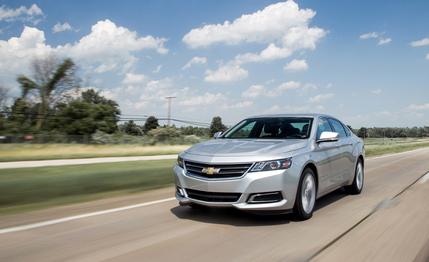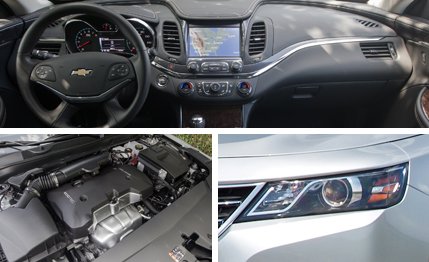 Instrumented Test
Instrumented Test
Psst! Hey, you. Over there in accounting. Yeah, you, in the short-sleeve shirt and tie. There’s a rumor that corporate is going to upgrade the company cars for all the junior execs. If it’s true, put me down for a 2014 Chevrolet Impala LT.
Wait! Before you laugh me out of your office, I mean cubicle, um, area, hear me out. The 2014 Impala is a far cry from that generic, fleet-filling lame duck from the 2013 model year. It’s new in almost every respect, including powertrain, sheetmetal, and interior appointments. Chevy has pinched and pulled the formerly androgynous exterior into a chiseled physique. Squint hard enough and you can make out a familial resemblance to the latest Camaro. Inside, the dash features an adventurous bi-level treatment accented with contrast stitching. A motorized eight-inch MyLink touch screen (standard on the LT and LTZ) rises from the center of the dash, revealing a storage cubby.
A bit porky at 3700 pounds, the LT carries its weight capably if not hurriedly with the standard 196-hp, naturally aspirated 2.5-liter inline-four. (You can step up to the 3.6-liter V-6 in 2LT trim.) Testing reveals a leisurely 8.7-second zero-to-60-mph time and a quarter-mile run in 16.8 seconds. You can do better for a getaway car, but the engine commits early and hangs on tenaciously until an upshift from the six-speed automatic arrives, either automatically or when prompted by a shifter button. The 2.5 is a hard-working four, but, thanks largely to a rubber-isolated front subframe, the coarser aspects of its personality stay out of the passenger compartment.
 Top: The Impalas interior has class-leading swoopiness. A cubby hides behind the nav screen, which uses icons that try too hard.
Top: The Impalas interior has class-leading swoopiness. A cubby hides behind the nav screen, which uses icons that try too hard.
Based on the same GM Epsilon II platform that underlies the Cadillac XTS and Buick LaCrosse, the Impala makes the most of its front-strut and rear-multilink suspension. It supplies a stable, well-damped ride, dispatching all but the most weathered pavement without losing composure. The variable-rate, electrically assisted rack-and-pinion steering is surprisingly accurate and quick, but it’s no ticker tape of road-texture information. This full-size sedan earned a lateral-acceleration number of 0.84 g on the 300-foot skidpad with mild understeer. What that figure can’t tell you is how composed the Impala remains right until its all-season Goodyears begin to howl.
The Impala stops well, but pedal feel is akin to kicking a waterlogged phone book. Thankfully, the ABS and electronic brake-force distribution sort out the details with a minimum of drama, and the lack of dive or squirm under hard braking is a welcome surprise. Stops from 70 mph consumed 168 feet with no fade in repeated attempts.
In fact, it’s such a complete package that I’d even shell out my own money for one. Sure, the mid-trim Impala LT will likely continue in its role as a go-to choice for you fellas in fleet management. But for the first time in years, the Impala isn’t a sedan of last resort. Now, where are we going for lunch, guys—Fuddruckers or T.G.I. Fridays?